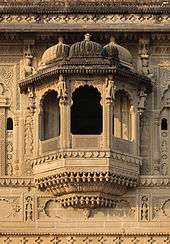Jharokha

A jharokha (or jharoka) is a type of overhanging enclosed balcony used in Architecture of Rajasthan . Jharokhas jutting forward from the wall plane could be used both for adding to the architectural beauty of the building itself or for a specific purpose. One of the most important functions it served was to allow women to see the events outside without being seen themselves. Alternatively, these windows could also be used to position archers and spies.
The jharokha is a stone window projecting from the wall face of a building, in an upper story, overlooking a street, market, court or any other open space. It is supported on two or more brackets or corbelling, has two pillars or pilaster, balustrade and a cupola or pyramidal roof; technically closed by jalies but generally partly open for the inmates to peep out to see passing processions. The jharokha is more formal and ornamental than English or French “oriel” and is one of the most distinctive characteristics of the façade in medieval Indian architecture until the 19th century.
The projected balcony is an essential element of Rajasthani architecture, both as decoration and as a viewing platform. The chajjas - sloping eaves that projected out above the balconies - increase protection from both the summer sun and monsoon rain. Jharokhas are mainly used in palaces, havelis and temples.
See also
External links
- ArchNet Dictionary of Indian Architecture: Jharokha
- Jharokha: An illustrated Glossary of Indian Architecture by Prof R Nath
